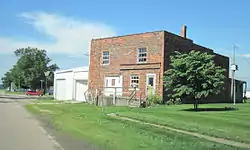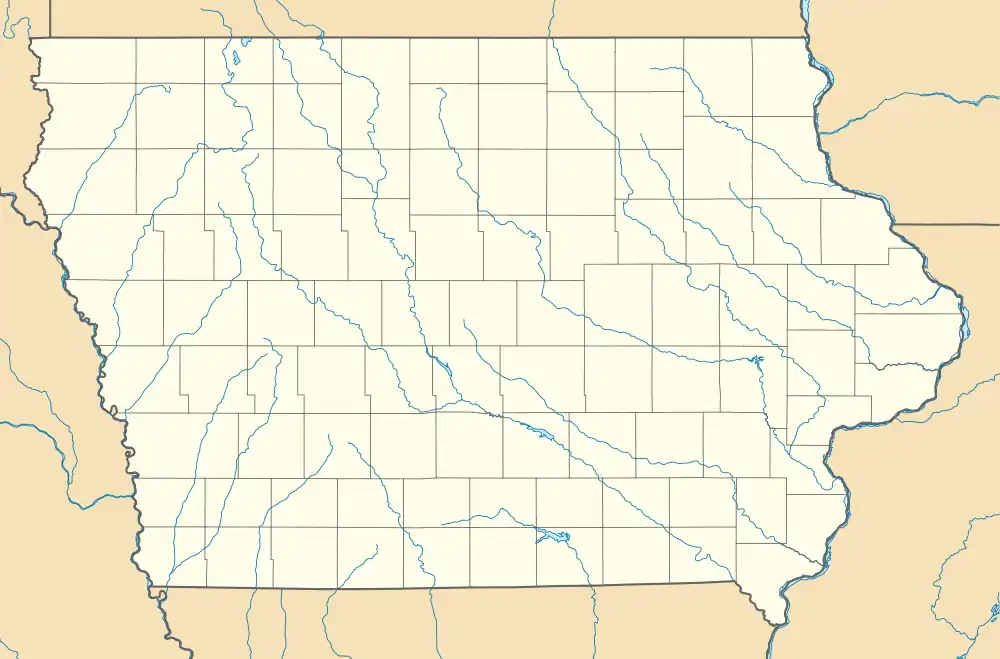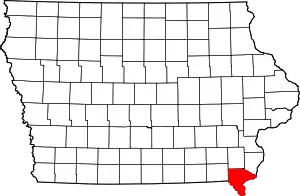Wever, Iowa | |
|---|---|
 Building in Wever | |
 Wever Location in Iowa  Wever Location in the United States | |
| Coordinates: 40°42′38″N 91°13′52″W / 40.71056°N 91.23111°W | |
| Country | United States |
| State | Iowa |
| County | Lee |
| Area | |
| • Total | 1.48 sq mi (3.82 km2) |
| • Land | 1.48 sq mi (3.82 km2) |
| • Water | 0.00 sq mi (0.00 km2) |
| Elevation | 561 ft (171 m) |
| Population (2020) | |
| • Total | 101 |
| • Density | 68.43/sq mi (26.42/km2) |
| Time zone | UTC-6 (Central (CST)) |
| • Summer (DST) | UTC-5 (CDT) |
| ZIP codes | 52658 |
| FIPS code | 19-84855 |
| GNIS feature ID | 462957[2] |
Wever is an unincorporated community in northeastern Lee County, in the southeastern corner of Iowa, United States. As of the 2020 census, its population was 101.[3]
Geography
Wever lies along U.S. Route 61, approximately eight miles northeast of the city of Fort Madison, one of two county seats in Lee County. It is just South of the Iowa Army Ammunition Plant and the Skunk River, which empties further east into the Mississippi River.[4] Its elevation is 561 feet (171 m).[2]
Demographics
| Census | Pop. | Note | %± |
|---|---|---|---|
| 2020 | 101 | — | |
| U.S. Decennial Census[5] | |||
History
Wever was a station on the Chicago, Burlington and Quincy Railroad.[6]
Although Wever is unincorporated, it has a post office, which opened on May 1, 1837. This post office has a complicated name history: it opened as 'Sand Ridge', changed to 'Green Bay' on September 17, 1849, to 'Jollyville' on January 28, 1859, and finally to Wever on October 17, 1870.[7] Its ZIP code is 52658.[8]
Wever was built around a station of the Chicago, Burlington and Quincy Railroad within Green Bay Township, and superseded the nearby town of Jollyville. It had 300 inhabitants when mentioned in the 1879 History of Lee County and was enjoying "good trade" because of the surrounding very fertile country.[9] Wever's population was 66 in 1902,[10] and had increased to 212 by 1925.[11]
The community is a part of the Fort Madison-Keokuk μSA.
20th century
In 1971, Mr. James Cook submitted the following statement about the fertilizer plant which Atlantic Richfield Company (ARCO) was operating in Green Bay Bottoms to produce anhydrous ammonia and diammonium phosphate fertilizers, to a US Senate committee: "ARCO Chemical Co., Division of Atlantic Richfield Co., Fort Madison, Iowa, May 20, 1971. To the U.S. House of Representatives, Committee on Appropriations, Subcommittee of Public Works, the U.S. Senate, Committee on Appropriations, Subcommittee of Public Works:
ARCO Chemical Company, a division of Atlantic Richfield Company, operates and maintains a fertilizer manufacturing complex adjacent to the Mississippi River in an area known as Green Bay bottoms. The capital cost of the complex was in excess of $60,000,000 and is entirely protected from the Mississippi River by levees. The plant significantly contributes to the economy of Fort Madison, Burlington, and surrounding communities. This complex of ARCO Chemical Company does employ approximately 1,000 people who are engaged in the manufacture, distribution and marketing of fertilizers, almost all of which are manufactured at this one facility. Any flooding of the Mississippi River at this point would have a detrimental effect to the company, an economic impact on the aforementioned communities and the earnings of a significant number of employees. Therefore, ARCO Chemical Company supports the continuing study by the Corps of Engineers in regard to the raising of the levees along the Mississippi River. G. T. Stocking, Vice President"[12]
In 1976, the EPA reported that the ARCO Chemical Co. fertilizer plant in Fort Madison, IA, had a wet-process phosphoric acid unit, which had come on stream in 1968, had an annual capacity of 225,000 short tons, expressed as P2O5[13]
21st century
In 2012, plans were announced to build a $1.4 billion fertilizer plant in Wever. The plant will use natural gas and is built by Orascom. Groundbreaking occurred in November 2012.[14] The WSJ wrote that US economic rebound and cheap energy from the shale-oil boom was luring investment from companies such as Egypt's Orascom.[15]
References
- ↑ "2020 U.S. Gazetteer Files". United States Census Bureau. Retrieved March 16, 2022.
- 1 2 "Wever, Iowa". Geographic Names Information System. United States Geological Survey, United States Department of the Interior.
- ↑ "2020: DEC Redistricting Data (PL 94-171)". United States Census Bureau. Retrieved November 18, 2021.
- ↑ Rand McNally. The Road Atlas '08. Chicago: Rand McNally, 2008, p. 39.
- ↑ "Census of Population and Housing". Census.gov. Retrieved June 4, 2016.
- ↑ The History of Lee County, Iowa. Western Historical Company. 1879. p. 679.
- ↑ U.S. Geological Survey Geographic Names Information System: Wever Post Office
- ↑ Zip Code Lookup
- ↑ The History of Lee County, Iowa. Western Historical Company. 1879. pp. 679.
- ↑ Cram's Modern Atlas: The New Unrivaled New Census Edition. J. R. Gray & Company. 1902. pp. 203–207.
- ↑ Company, Rand McNally and (1925). Premier Atlas of the World: Containing Maps of All Countries of the World, with the Most Recent Boundary Decisions, and Maps of All the States, Territories, and Possessions of the United States with Population Figures from the Latest Official Census Reports, Also Data of Interest Concerning International and Domestic Political Questions. Rand McNally & Company. p. 190.
- ↑ Appropriations, United States Congress Senate Committee on (1971). Public Works for Water and Power Development and Atomic Energy Commission Appropriations for Fiscal Year 1972: Hearings Before a Subcommittee of the Committee on Appropriations, United States Senate, Ninety-second Congress, First Session. U.S. Government Printing Office.
- ↑ Control of Fluoride Emissions from Existing Phosphate Fertilizer Plants : Draft Guideline Document, page 47, Table 3-3, available at https://nepis.epa.gov/Exe/ZyNET.exe/9101PNA6.txt?ZyActionD=ZyDocument&Client=EPA&Index=1976%20Thru%201980&Docs=&Query=&Time=&EndTime=&SearchMethod=1&TocRestrict=n&Toc=&TocEntry=&QField=&QFieldYear=&QFieldMonth=&QFieldDay=&UseQField=&IntQFieldOp=0&ExtQFieldOp=0&XmlQuery=&File=D%3A%5CZYFILES%5CINDEX%20DATA%5C76THRU80%5CTXT%5C00000033%5C9101PNA6.txt&User=ANONYMOUS&Password=anonymous&SortMethod=h%7C-&MaximumDocuments=1&FuzzyDegree=0&ImageQuality=r75g8/r75g8/x150y150g16/i425&Display=hpfr&DefSeekPage=x&SearchBack=ZyActionL&Back=ZyActionS&BackDesc=Results%20page&MaximumPages=1&ZyEntry=47
- ↑ Rod Swoboda (November 28, 2012). "Iowa Fertilizer Company Begins Construction on New Plant". FarmProgress. Penton. Retrieved February 21, 2015.
- ↑ William Boston (December 17, 2013). "BASF Steps Up Investment in U.S. ·". Wall Street Journal. Dow Jones.
